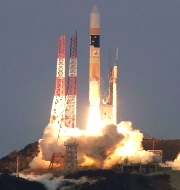Japan to conduct world’s first test of space elevator
Japanese researchers from Shizuoka University will conduct world’s first experiment to test small prototype of space elevator in space by using two mini satellites. The test equipment will be launched by Japan’s space agency on board of H-2B rocket from southern island of Tanegashima.
Key Facts
In this experiment, two ultra-small cubic satellites developed by Shizuoka University Faculty of Engineering will be used for demonstration of space elevator technology. Each satellite measures 10 centimeters each side. Roughly 10-meter-long steel cable will be employed to connect twin satellites. The pair of satellites will be released from International Space Station (ISS) and container acting like elevator car will be moved on cable connecting satellites using motor. The movement of motorised elevator box will be monitored with cameras in the satellites.
Space elevator
It is proposed type of planet-to-space transportation system. Its components mainly are cable (also called tether) anchored to surface of planet and extending into space. It will permit vehicles to travel along cable from planetary surface, such as Earth’s, directly into space or orbit, without use of large rockets. The idea of space elevator was first proposed in 1895 by Russian scientist Konstantin Tsiolkovsky after he saw Eiffel Tower in Paris and later it was revisited nearly century later in novel by Arthur C. Clarke.
The one end of cable of space elevator will be attached near to surface and the other end in space beyond geostationary orbit (35,786 km altitude). The competing forces of gravity, which is stronger at lower end and outward or upward centrifugal force, which is stronger at upper end, will result in the cable being held up, under tension, and stationary over single position on Earth. Once cable (tether) is deployed at fixed position, climbers can repeatedly climb it to venture into space by mechanical means, releasing their cargo to orbit. Climbers also can descend ether to return cargo to surface from orbit.

Month: Current Affairs - September, 2018


